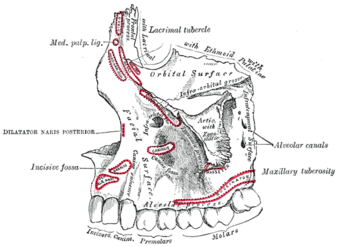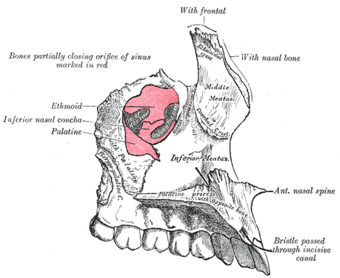Body of maxilla
Lua error in package.lua at line 80: module 'strict' not found. Lua error in package.lua at line 80: module 'strict' not found.
| Body of maxilla | |
|---|---|

Left maxilla. Outer surface.
|
|

Left maxilla. Nasal surface.
|
|
| Details | |
| Latin | corpus maxillae |
| Identifiers | |
| Dorlands /Elsevier |
c_56/12260607 |
| TA | Lua error in Module:Wikidata at line 744: attempt to index field 'wikibase' (a nil value). |
| TH | {{#property:P1694}} |
| TE | {{#property:P1693}} |
| FMA | {{#property:P1402}} |
| Anatomical terms of bone
[[[d:Lua error in Module:Wikidata at line 863: attempt to index field 'wikibase' (a nil value).|edit on Wikidata]]]
|
|
The body of the maxilla is somewhat pyramidal in shape, and contains a large cavity, the maxillary sinus (antrum of Highmore). It has four surfaces; the anterior surface, the orbital or superior surface, the nasal or medial surface and the infratemporal or posterior surface.
Surfaces
The orbital surface of the maxilla is smooth and triangular. It forms most of the floor of the orbit, the cavity that contains the eyeball and its vessels. At its middle border is an irregular margin at the front of which is the lacrimal groove or notch, and behind this groove, the margin articulates with the thin plate of ethmoid bone (lamina papyracea) and the orbital process of the hard palate (palatine). To the side of the lacrimal notch is a depression which gives rise to the oblique inferior oculi. (obliquus oculi inferior). Its back border is a smooth rounded edge and this forms the front margin of the inferior orbital (infraorbital) fissure. This groove or fissure, carries the infraorbital vessels and nerve. Sometimes it joins at the side with part of the sphenoid bone.
The orbital surface is limited at the front by part of the orbit’s circumference. The infraorbital groove passes forward and ends in the infraorbital canal; this branches to give a second small canal that runs off from this, downwards into the front wall of the sinus where it carries the anterior superior alveolar vessels and nerve to the front teeth of the maxilla. Sometimes a second canal is given off that travels down in the lateral wall of the sinus and carries the middle alveolar nerve to the premolar teeth.
The front, or anterior surface of the maxilla is directed forwards and to the side. At its lower part are a series of small raised parts which correspond to the positions of the roots of the teeth. Above the incisor teeth locations there is a shallow depression, the incisive fossa, and this gives rise to the depressor alae nasi. Below the incisive fossa, the alveolar (tooth cavity) is attached to a segment of the orbicular oris and a little above and to the side, the nasalis muscle arises. To the side of the incisor fossa is the larger and deeper canine fossa and these are separated by a vertical ridge, the canine eminence. The canine fossa gives origin to the levator anguli oris.
Above the fossa, the infraorbital canal ends in the infraorbital foramen an opening that transmits the infraorbital vessels and nerve. The margin of the orbit is above this opening and this provides attachment to part of the quadratus labii superioris. Towards the middle on the anterior surface the deep concavity of the nasal notch is the limiting feature. From this is attached the back of the dilator naris and ends below in a pointed process. This process joins with that on the opposite side to form the anterior nasal spine.
On the nasal surface of the maxilla is a large irregular opening that leads into the maxillary sinus. At its upper edge are some broken air cells which are closed in by the ethmoid and lacrimal bones. Below the opening is a smooth concavity which forms part of the lower opening or (inferior meatus) of the nasal cavity. Behind the opening is a rough surface for articulation with the perpendicular part of the hard palate. This rough area is crossed by a groove which starts near to the middle at the back and runs obliquely down and forward. The palatine bone (hard palate) converts the groove into a canal, the pterygopalatine canal.
In front of the opening of the sinus is a deep lacrimal groove which the lacrimal bone and inferior nasal concha convert into the nasolacrimal canal, which transmits the nasolacrimal duct. Further in front runs an oblique ridge, the conchal crest which articulates with the inferior nasal concha. The shallow concavity above this ridge forms part of the atrium of the middle opening of the nose and below it part of the lower opening (inferior meatus).
The infratemporal surface (below the temple) is convex, directed to the back and to the side, and forms part of the infratemporal fossa. It is separated from the anterior surface by the zygomatic process and by a strong ridge, extending upward from the socket of the first molar tooth. It is pierced about its center by the apertures of the alveolar canals, which transmit the posterior superior alveolar vessels and nerves.
At the lower part of this surface is a rounded eminence, the maxillary tuberosity, especially prominent after the growth of the wisdom teeth; it is rough on its lateral side for articulation with the pyramidal process and in some cases articulates with the lateral pterygoid plate of the sphenoid. It gives origin to a few fibers of the internal pterygoid muscle. Immediately above this is a smooth surface, which forms the anterior boundary of the pterygopalatine fossa, and presents a groove, for the maxillary nerve; this groove is directed lateralward and slightly upward, and is continuous with the infraorbital groove on the orbital surface.